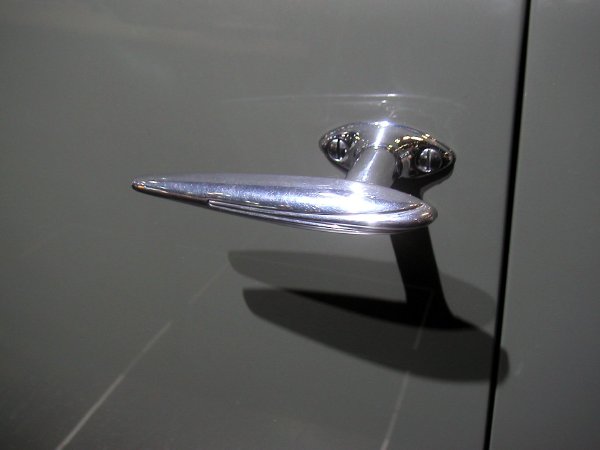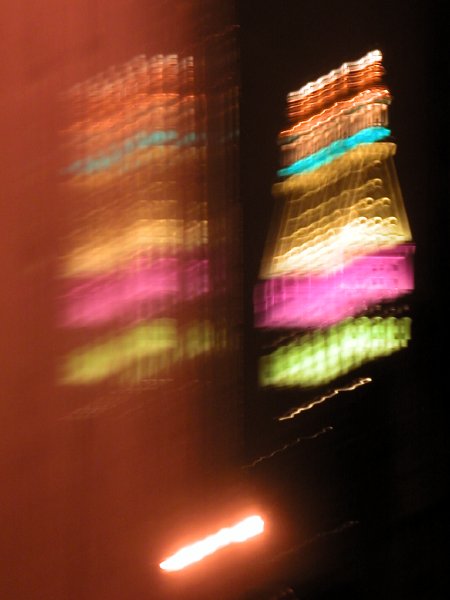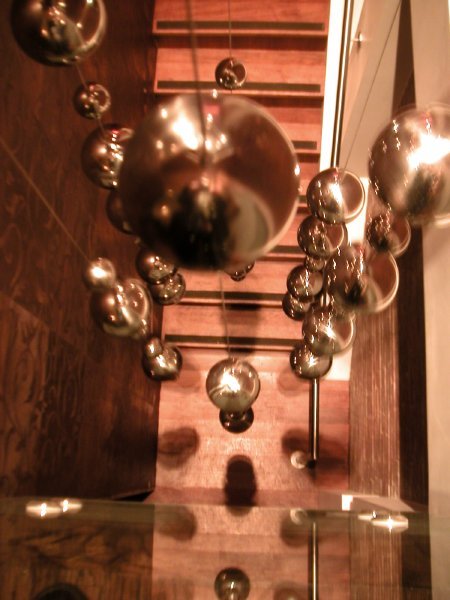
untitled (1936 Lincoln Zephyr door handle) 2005
I saw no vehicle which pleased me more at the New York auto show than this seventy-year-old prop for the introduction of one manufacturer's 2006 model.
I spent the entire afternoon at the show on Monday, but I don't know why I bother anymore. The cars being sold to Americans are, almost without exception, pure junk and an appalling assault on the planet. We get to choose between trucks and "sport utility vehicles" (with no real truck, sport or utility capability) and the occasional but equally-ugly sedan or lets-pretend "sports" car.
Virtually every one of these adult toys is intended to do little more than satisfy the fantasies of a 16-year-old with nothing other than his member or the implied violence of speed on his mind. I suppose if your waking life revolves around driving, as it seems to for most Americans, what else is there to guide your transportation decisions? The few exceptions to that infantile appeal of the guy-demographic which manage to squeeze through are condemned as chick cars and either discontinued or pumped with steroids and the carworld equivalent of graceless football padding.
Only if you've ever been outside the country would you be likely to realize that nothing is really small in the American automobile market. We have no sense of proportion, and I mean that here in every sense. Even if it starts out with a modest footprint when introduced, any relatively compact vehicle is inevitably designed and equipped as a cheap substitute for the heroic virtues of the real thing. If it isn't ignored and doesn't quickly disappear it begins its inexorable course on the path toward gigantism with the very next model change. Has anyone seen a Geo Metro or Ford Fiesta lately, or looked at what passes for a Honda Civic these days? Remember when a Civic was smaller than the original Mini? [thanks, David, for the reminder]
Some of us have noticed that this commercial exhibition is being staged in the middle of the most urban civilization in a country engaged in wars over access to the world's finite supply of oil. The NYTimes "Automobiles" section pointed out on Monday, there was not one city car in sight at the Javits Center.
In Europe, the "city car" is a well-understood concept, a vehicle whose dimensions and design are as ideally suited to its duties as the minivan's multiple seats and cup holders are to its role in American suburbs. A city car is one intended primarily for urban use. Its size makes it economical and easy to park and lets it slip between huge trucks clogging the narrow streets. And, yes, a city car is a bit sophisticated in style.Anyone who has travelled to Europe knows that vehicles there, whether "city cars" or not, are for grown-ups who want and get intelligence, beauty and function regardless of their transportation choices. If nothing else will bring us to our senses over here, perhaps the thought of billions of newly-prosperous car fans in Asia shopping for their own SUVs - and the oil to propel them - will be able to do it through self-interest.In New York, a city car is not a tiny car. "Every time I come here I'm struck by the scale of vehicles," Ed Welburn, vice president for global design at General Motors, said at the auto show last week. "It is unlike any other city in the world."
I don't believe I'm reading too much into the phenomenon if I say I really believe the design and scale of the cars we drive in the U.S. represents our increasing indifference to, hatred or fear of all the people on the outside ("the other"), however we define that.
Oh yeah, for what it's worth, I don't have a car of my own, and haven't since moving to New York. But while I firmly believe in public transportation I'm fascinated with small, efficient vehicles and the idea of sharing their use whenever they might be needed. All of this seems to make me very un-American.

